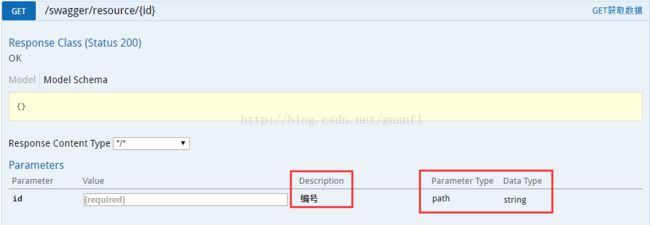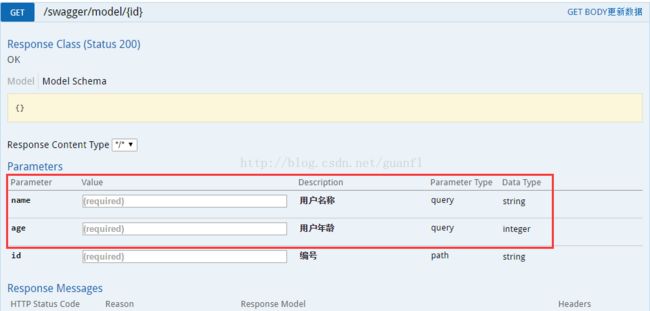Swagger Annotations
以下是swagger-anntations-1.5.9.jar中的所有类(注解)
Api.class
ApiImplicitParam.classApiImplicitParams.class
ApiModel.class
ApiModelProperty.class
ApiOperation.class
ApiParam.class
ApiResponse.class
ApiResponses.class
Authorization.class
AuthorizationScope.class
Contact.class
Example.class
ExampleProperty.class
Extension.class
ExtensionProperty.class
ExternalDocs.class
Info.class
License.class
ResponseHeader.class
SwaggerDefinition.class
Tag.class
@Api 标记一个类为Swagger资源(开放的API)通过description来描述其功能。如:@Api(value = "restful", description = "关于Restful接口文档注释")
@ApiOperation 描述HTTP 方法类型对应的一个操作 CRUD,value和notes来描述其功能 如:@ApiOperation(value = "GET获取数据",produces="application/json")
@ApiParam 描述请求参数 @ApiParam(name = "id", value = "编号", required = true)
@ApiImplicitParams (@ApiImplicitParam) 与@ApiParm功能相同都是对请求参数的注释
最后结果:
@ApiParam 注释请求参数,自动探测参数类型、参数对应类型path、query、heaer、body等信息
@ApiParam遇到POST请求消息体 JSON封装的数据,SpringMVC使用User等实体类接收时
@ApiOperation(value = "POST BODY更新数据")
@RequestMapping(value = "resources/{id}", method = RequestMethod.POST)
public ResponseEntity bodyResource(@ApiParam(value="用户",required=true) @RequestBody User user,
@ApiParam(name = "id", value = "编号", required = true) @PathVariable String id){
System.out.println(user);
ModelMap modelMap = new ModelMap();
modelMap.put("status", HttpStatus.OK.value());
modelMap.put("timestamps",System.currentTimeMillis());
modelMap.put("msg", HttpStatus.OK.getReasonPhrase());
modelMap.put("user", user);
modelMap.put("apiversion", 2);
return ResponseEntity.status(HttpStatus.OK).body(modelMap);
} User实体类:
/**
* ClassName : User.java
* Create on :2017年1月19日
* Copyrights 2017 guanfl All rights reserved.
* Email : [email protected]
*/
package com.github.pojo;
import io.swagger.annotations.ApiModel;
import io.swagger.annotations.ApiModelProperty;
@ApiModel("用户描述")
public class User {
@ApiModelProperty(value="用户名称",required=true)
private String name;
@ApiModelProperty(value="用户年龄",required=true)
private Integer age;
public String getName() {
return name;
}
public void setName(String name) {
this.name = name;
}
public Integer getAge() {
return age;
}
public void setAge(Integer age) {
this.age = age;
}
@Override
public String toString() {
return "User [name=" + name + ", age=" + age + "]";
}
}效果:
@ApiParam 请求参数使用@ModelAttribute 接收参数并转换成实体对象
@ApiOperation(value = "GET BODY更新数据")
@RequestMapping(value = "model/{id}", method = RequestMethod.GET)
public ResponseEntity modelResource(@ApiParam(value="用户",required=true) @ModelAttribute User user,
@ApiParam(name = "id", value = "编号", required = true) @PathVariable String id){
System.out.println(user);
ModelMap modelMap = new ModelMap();
modelMap.put("status", HttpStatus.OK.value());
modelMap.put("timestamps",System.currentTimeMillis());
modelMap.put("msg", HttpStatus.OK.getReasonPhrase());
modelMap.put("user", user);
modelMap.put("apiversion", 2);
return ResponseEntity.status(HttpStatus.OK).body(modelMap);
} 


